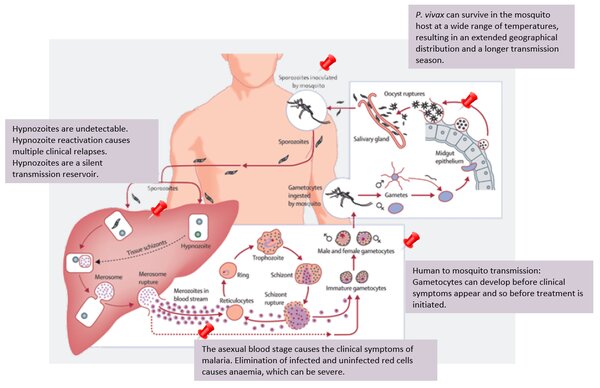Lifecycle of Plasmodium vivax malaria
The P. vivax lifecycle is complex, including more than ten stages of cellular differentiation, with the parasite invading at least four types of cells within two different hosts.
Mosquito to human transmission
- During a blood meal, a malaria-infected female Anopheles mosquito inoculates sporozoites into the human host.
- Sporozoites from the mosquito migrate to the liver, where they mature into schizonts, which rupture and release merozoites.
- Another stage of the malaria parasite, called the hypnozoite, can remain dormant and persist in the liver for months.
Hypnozoites
- Undetectable with current diagnostic methods, hypnozoites in the human liver may reactivate weeks or months after the initial infection, leading to multiple clinical relapses and onward transmission.
- It is unknown how many people in P. vivax malaria endemic areas are hypnozoite carriers. Thus, hypnozoites represent a silent transmission reservoir.
Asexual blood stage infection
- Following their release into the blood, merozoites invade reticulocytes (immature red blood cells), and mature into schizonts which rupture to accelerate the infection. This asexual erythrocytic stage (or blood stage) causes the symptoms of malaria which appear about 48 h after infection.
- The blood stage causes the elimination of infected and uninfected red cells resulting in anaemia, which can be severe.
Sexual stage infection
- Merozoites also differentiate into the infectious stage (sexual stage), gametocytes.
- In P. vivax malaria, gametocytes can be produced before clinical symptoms, which may allow transmission before the host feels unwell or receives treatment.
